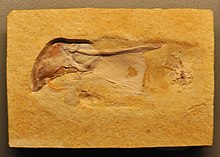Teudopseina
| Teudopseina Temporal range: | |
|---|---|
 | |
| Fossil of Muensterella scutellaris | |
| Scientific classification | |
| Domain: | Eukaryota |
| Kingdom: | Animalia |
| Phylum: | Mollusca |
| Class: | Cephalopoda |
| Order: | Octopoda |
| Suborder: | †Teudopseina Roger, 1952 |
| Subgroups | |
The Teudopseina is a clade of stem-octopods that first evolved in the Toarcian,[1] considered the largest clade of gladius-bearing coleoids in the Mesozoic. Up to five families are known, among which the Trachyteuthidae, Trachyteuthis in particular, were the most abundant.[2]
Description[edit]
The Teudopseina can be united by five primary traits. These are the presence of a gladius, a reduced, spoon-shaped conus, a median field that is distinctly rounded or pointed anteriorly, weakly curved hyperbolar zones, and lateral fields shorter than the hyperbolar zones.[2] Members of the superfamily Muensterelloidea are characterized by a spoon-shaped section of the gladius, known as the patella. This is believed to be ancestral to the condition present in modern octopuses.[3]
Taxonomy[edit]
The current consensus is that the Teudopseina forms a stem-group of the Octopoda.[4][5] Certain taxa, such as Enchoteuthis, have sometimes been classified as either relatives of giant squids or vampire squids.[citation needed]
References[edit]
- ^ Fuchs, Dirk & Weis, Robert. (2010). Taxonomy, morphology and phylogeny of Lower Jurassic teudopseid coleoids (Cephalopoda). Neues Jahrbuch für Geologie und Paläontologie - Abhandlungen. 257. 351-366. 10.1127/0077-7749/2010/0083.
- ^ a b Tree of Life Project: Teudopseina. Tree of Life Web Project. Retrieved 2022-01-15.
- ^ Fuchs, D.; Schweigert, G. (2018). "First Middle–Late Jurassic gladius vestiges provide new evidence on the detailed origin of incirrate and cirrate octopuses (Coleoidea)". PalZ. 92 (2): 203–217. doi:10.1007/s12542-017-0399-8. S2CID 135245479.
- ^ Haas, W. 2002. The evolutionary history of the eight-armed Coleoidea. Abhandlungen der Geologischen Bundesanstalt 57: 341-351.
- ^ "Fuchs, D. 2009. Octobrachia - a diphyletic origin? Berliner Paläobiologische Abhandlungen 10: 182-192."


 French
French Deutsch
Deutsch